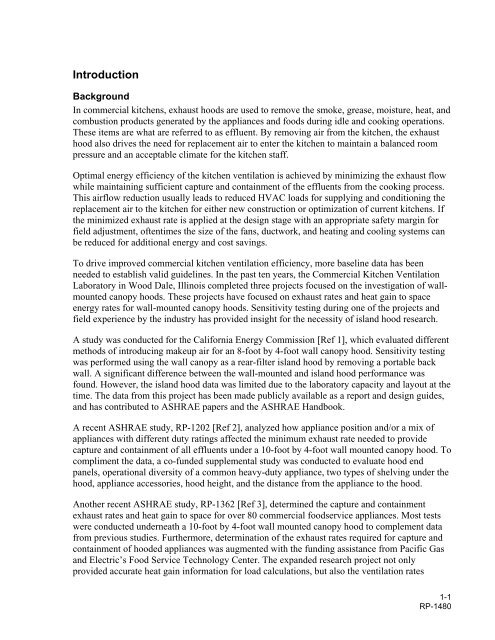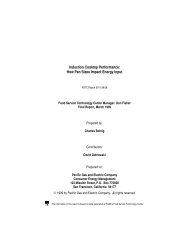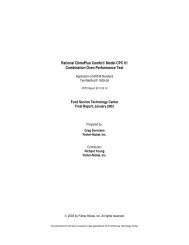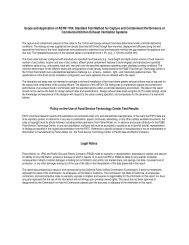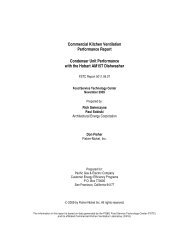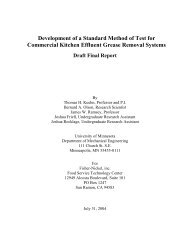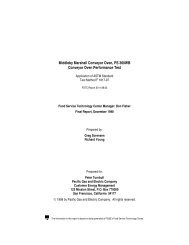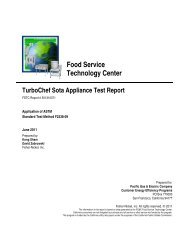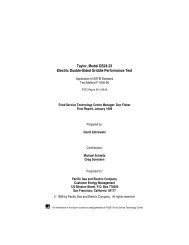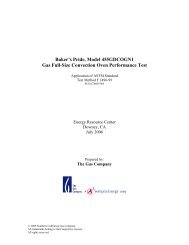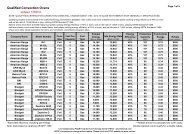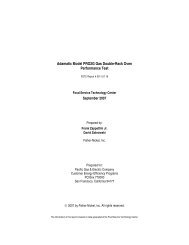ASHRAE Research Project 1480 Report - Food Service Technology ...
ASHRAE Research Project 1480 Report - Food Service Technology ...
ASHRAE Research Project 1480 Report - Food Service Technology ...
You also want an ePaper? Increase the reach of your titles
YUMPU automatically turns print PDFs into web optimized ePapers that Google loves.
Introduction<br />
Background<br />
In commercial kitchens, exhaust hoods are used to remove the smoke, grease, moisture, heat, and<br />
combustion products generated by the appliances and foods during idle and cooking operations.<br />
These items are what are referred to as effluent. By removing air from the kitchen, the exhaust<br />
hood also drives the need for replacement air to enter the kitchen to maintain a balanced room<br />
pressure and an acceptable climate for the kitchen staff.<br />
Optimal energy efficiency of the kitchen ventilation is achieved by minimizing the exhaust flow<br />
while maintaining sufficient capture and containment of the effluents from the cooking process.<br />
This airflow reduction usually leads to reduced HVAC loads for supplying and conditioning the<br />
replacement air to the kitchen for either new construction or optimization of current kitchens. If<br />
the minimized exhaust rate is applied at the design stage with an appropriate safety margin for<br />
field adjustment, oftentimes the size of the fans, ductwork, and heating and cooling systems can<br />
be reduced for additional energy and cost savings.<br />
To drive improved commercial kitchen ventilation efficiency, more baseline data has been<br />
needed to establish valid guidelines. In the past ten years, the Commercial Kitchen Ventilation<br />
Laboratory in Wood Dale, Illinois completed three projects focused on the investigation of wallmounted<br />
canopy hoods. These projects have focused on exhaust rates and heat gain to space<br />
energy rates for wall-mounted canopy hoods. Sensitivity testing during one of the projects and<br />
field experience by the industry has provided insight for the necessity of island hood research.<br />
A study was conducted for the California Energy Commission [Ref 1], which evaluated different<br />
methods of introducing makeup air for an 8-foot by 4-foot wall canopy hood. Sensitivity testing<br />
was performed using the wall canopy as a rear-filter island hood by removing a portable back<br />
wall. A significant difference between the wall-mounted and island hood performance was<br />
found. However, the island hood data was limited due to the laboratory capacity and layout at the<br />
time. The data from this project has been made publicly available as a report and design guides,<br />
and has contributed to <strong>ASHRAE</strong> papers and the <strong>ASHRAE</strong> Handbook.<br />
A recent <strong>ASHRAE</strong> study, RP-1202 [Ref 2], analyzed how appliance position and/or a mix of<br />
appliances with different duty ratings affected the minimum exhaust rate needed to provide<br />
capture and containment of all effluents under a 10-foot by 4-foot wall mounted canopy hood. To<br />
compliment the data, a co-funded supplemental study was conducted to evaluate hood end<br />
panels, operational diversity of a common heavy-duty appliance, two types of shelving under the<br />
hood, appliance accessories, hood height, and the distance from the appliance to the hood.<br />
Another recent <strong>ASHRAE</strong> study, RP-1362 [Ref 3], determined the capture and containment<br />
exhaust rates and heat gain to space for over 80 commercial foodservice appliances. Most tests<br />
were conducted underneath a 10-foot by 4-foot wall mounted canopy hood to complement data<br />
from previous studies. Furthermore, determination of the exhaust rates required for capture and<br />
containment of hooded appliances was augmented with the funding assistance from Pacific Gas<br />
and Electric’s <strong>Food</strong> <strong>Service</strong> <strong>Technology</strong> Center. The expanded research project not only<br />
provided accurate heat gain information for load calculations, but also the ventilation rates<br />
1-1<br />
RP-<strong>1480</strong>


